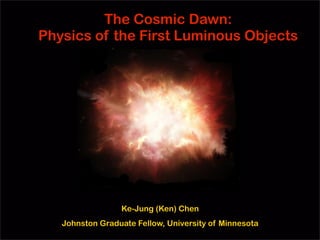
Sigma2013_kejungchen
- 1. The Cosmic Dawn: Physics of the First Luminous Objects Ke-Jung (Ken) Chen Johnston Graduate Fellow, University of Minnesota
- 3. The First Stars Abel, et al. Science (2002) Bromm, et al. Nature (2009) Mass Scale ~ 100-1000 M⊙
- 4. The Death of Massive Stars Woosley, Heger, & Weaver (2002) MS Mass He Core Supernova Mechanism 10 ≤ M ≤ 85 2 ≤ M ≤ 32 Fe core collapse to a neutron star or black hole (GRB Talks: Aloy, Matsumoto, Mizuta) (CCSNe Talk by Suwa ) 80 ≤ M ≤ 150 35 ≤ M ≤ 60 Pulsational pair instability followed by core (PPSN) 150 ≤ M ≤ 250 60 ≤ M ≤ 133 Pair instability supernova (PSN) 250 ≤ M 133 ≤ M Black holes Mass Unit: solar mass ⊙
- 8. How to Model 3D Supernovae 1D Models 80 - 150 M⊙ Stars (Woosley+ 2007, priv. comm.) 150 - 250 M⊙ Stars (Heger & Woosley 2002, 2010) CASTRO (DOE SciDAC Computational Astrophysics Team) Massive Parallel, Adaptive Mesh Refinement (AMR), Multi-D, Radiation, Hydro, +( Nuclear Burning, Mapping, Rotation, GR, ... ) (Almgren+ 2010, Zheng+ 2011 2012, Chen+ 2011 2012) Supercomputers Itasca Franklin Hopper Jaguar
- 9. Explosion of a 110 M⊙ Star (Chen+ Nature 2013)
- 10. Explosion of a 200 M⊙ Star
- 11. More Explosions ! (Chen+ 2012) BSG 150 BSG 200 BSG 250 No Bang !! form a black hole RSG 150 RSG 200 RSG 250
- 13. Results Mass Core E Ni Model 52 erg] [M⊙] Instab. Mixing [M⊙] [M⊙] [10 B150 150 67 1.29 0.07 Burning weak B200 200 95 4.14 6.57 Burning weak B250 250 109 7.23 28.05 Burning weak R150 150 59 1.19 0.10 Rev. Strong R200 200 86 3.43 4.66 Rev. Strong R250 250 156 ... ... ... ... Ni is only slightly mixed out . The Gamma-Ray emission for PSNe is unlikely.
- 14. Conclusions Fate Very Bright Sources Observation 80 ~ 150 M⊙ PPSN YES Pop I, II, III Multi-SN 150 ~ 250 M⊙ PSN YES Pop I(?), II, III Large Ni 250+ M⊙ BH(?) No No GW Mixing can be important ! 13
- 15. Formation of the First Galaxies ? z ~ 10 👍 time z ~ 20 👍👍
- 16. Characters of the First Galaxies Bromm, & Yoshida (2011) • Mass scale ~ 108 M⊙ • Redshift ~ 10 • Self-bound system. • Affected from the previous stellar feedback • Hosted the Pop III and Pop II stars
- 17. Modeling the Galaxy Formation Gadget-2 ( Springel 2005) 1. Star formation 2. Radiative transfer 3. Diffusion mixing 4. Chemical cooling Bromm+ 2002,2003 Johnson+ 2007 Greif+ 2009, 2010 Jeon+ 2012 Possible radiative feedbacks 1. Ionizing photons 2. SN shock reheating 3. X-Ray Binaries Chemical enrichment 1. SN feedback
- 18. Impact of the First Stars and Supernovae
- 19. Conclusions • All possible radiative feedback 1. Ionizing photons 2. SN shock reheating 3. X-Ray Binaries • Chemical enrichment 1. SN feedback 2. Pop III to Pop II transition The impact of the first stars holds the key to the later galaxy formation!!
- 20. The cosmic dawn may be observed by
- 21. Many thanks for your attention My work has been kindly supported by:
